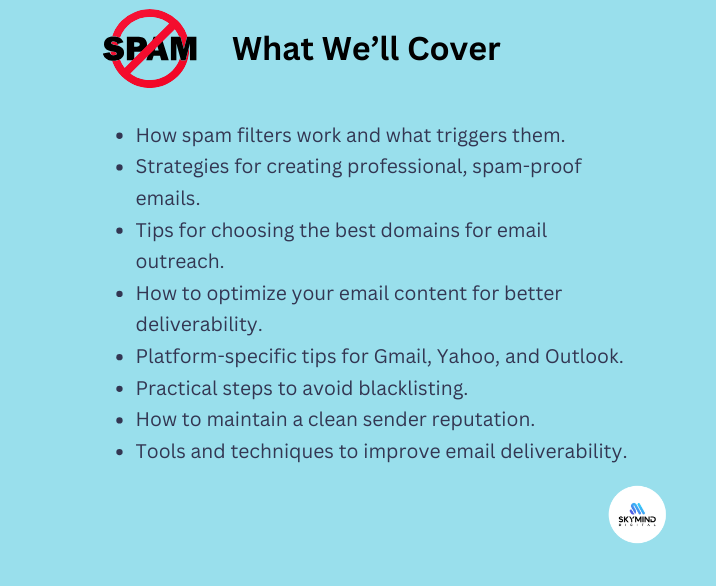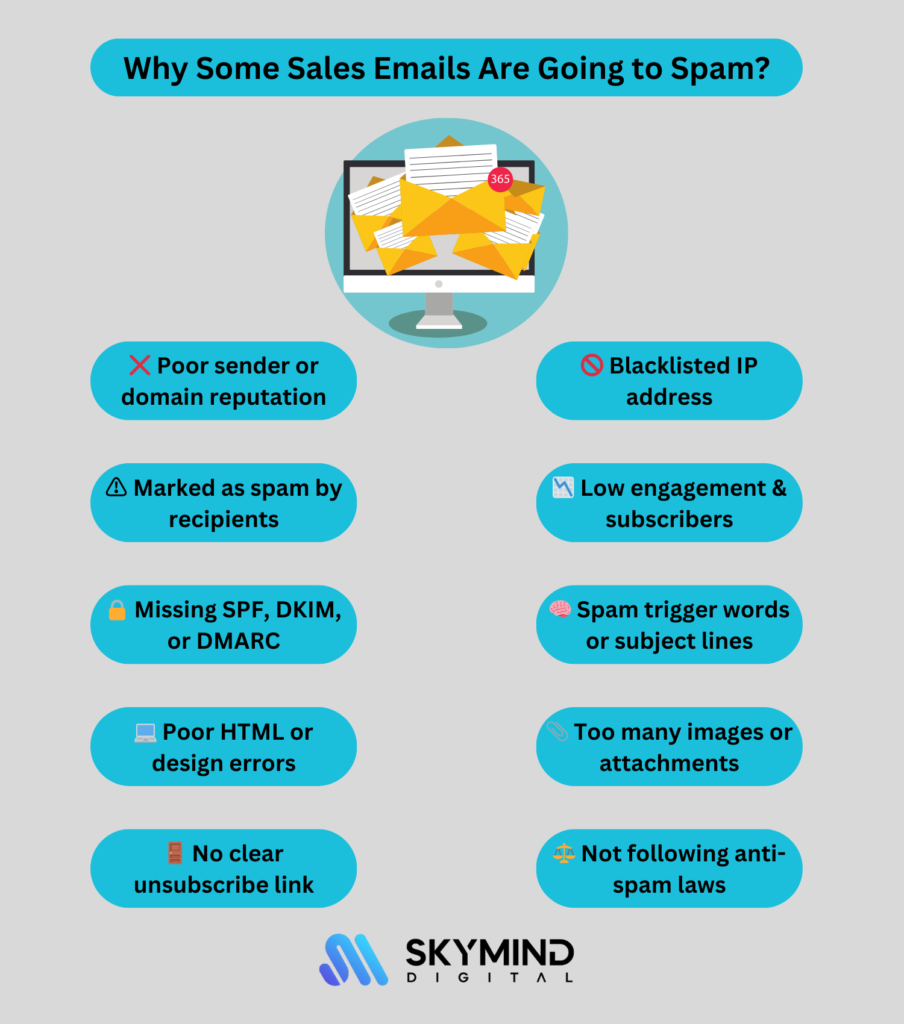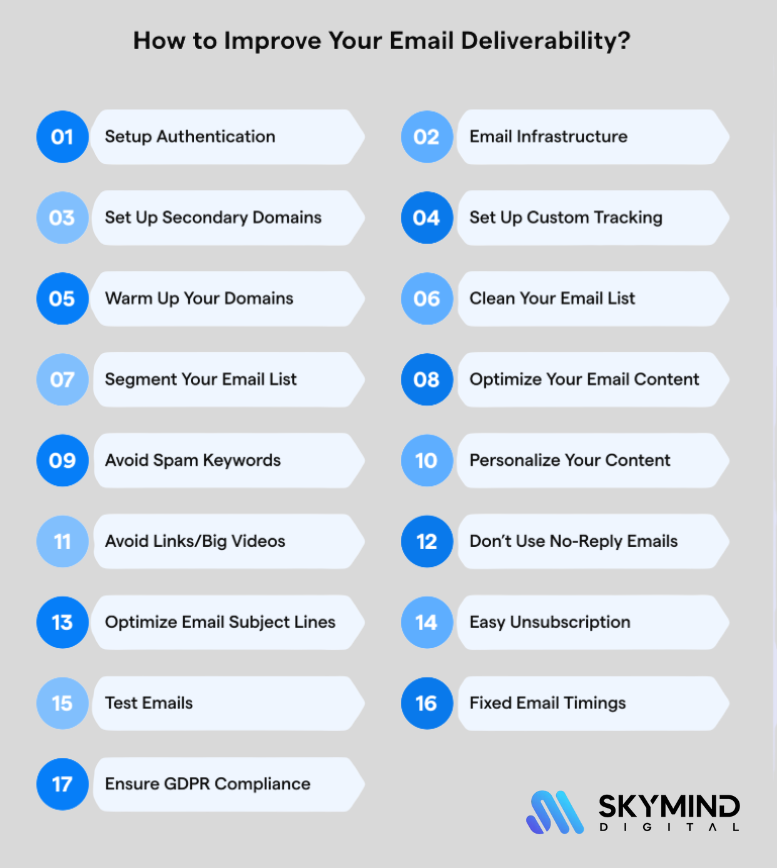Spam filters are a big challenge for anyone trying to connect through email, whether it’s for sales, networking, or marketing campaigns. These filters are designed to protect inboxes from unwanted or harmful messages, but they can also block legitimate emails.
If your emails end up in the spam folder, your message may never reach its audience, costing you valuable opportunities.
Why do some sales emails go to spam? Common reasons include spammy language, sending too many emails at once, or using unverified email domains.
According to Statista, nearly 85% of global email traffic is considered spam, which makes email providers extra cautious.
As a result, even well-crafted emails can be flagged if they trigger spam filters.
Understanding how to avoid email spam filters is crucial for ensuring your emails reach the right people. This guide will show you how to stay out of the spam folder and improve your email deliverability.
What This Guide Will Cover?

In this guide, you’ll learn how spam filters work and what triggers them. We’ll cover strategies for creating professional, spam-proof emails, choosing the best domains, and optimizing your email content.
You’ll also discover platform-specific tips for Gmail, Yahoo, and Outlook, along with practical steps to prevent blacklisting and maintain a clean sender reputation.
By the end, you’ll have all the tools you need to improve deliverability and ensure your emails reach their intended audience. Let’s get started!
Why Do Emails End Up in a Spam Folder?
Understanding Spam Filters

Spam filters are automated systems designed to protect users from unwanted or harmful emails. They analyze incoming messages using complex algorithms and assign them a “spam score.” If the score exceeds a certain threshold, the email is sent to the spam folder instead of the inbox.
Different email platforms like Gmail, Outlook, and Yahoo use unique filtering methods.
Gmail’s filters, for example, are known for triggering alerts based on patterns like suspicious domains, misleading subject lines, or excessive promotional content.
Similarly, Outlook flags emails that lack proper authentication, and Yahoo closely monitors sender reputation and IP address history.
E-mail filtering is becoming smarter with the use of AI, but even legitimate emails can get flagged. This happens when the email contains elements that resemble spam, like generic phrases or poor formatting.
To avoid spam filters, it’s essential to understand how they evaluate emails and adjust your strategies accordingly.
Why Some Sales Emails Are Going to Spam?

Sales emails are crucial for reaching customers, but if yours keep landing in spam folders, you’re wasting time and money. Let’s uncover why this happens and how to fix it—no tech jargon, just straight talk.
- Your Email “Street Cred” Is Low
Email providers (like Gmail or Outlook) treat your sales emails like a stranger knocking on a door. If they don’t recognize you or trust you, they’ll slam the door shut.
- Bad Sender Reputation: If your domain or IP address has been flagged for spammy behavior (e.g., blasting generic pitches or buying shady email lists), providers will block you.
- Blacklisted IPs: If your server’s IP is on a spam blacklist (like Spamhaus), your emails won’t reach anyone’s inbox.
- New or Unverified Domains: Fresh domains or ones that rarely send emails look suspicious. Build trust slowly, like warming up a cold lead.
- Your Audience Isn’t Engaged (Or Worse, Annoyed)
Even if your setup is flawless, poor audience interaction tanks deliverability. Sales teams often make these mistakes:
- Recipients Mark You as Spam: If people flag your emails, providers assume you’re a nuisance. Why this happens: Over-aggressive follow-ups, irrelevant offers, or emailing people who never signed up.
- Low Open/Click Rates: If nobody opens or clicks, providers think your emails are unwanted. Sound familiar? Generic subject lines (“Buy Now!”) or impersonal pitches often fail here.
- Dead-Weight Subscribers: Inactive contacts (e.g., old leads who haven’t engaged in 6+ months) hurt your reputation. They’re like silent critics dragging you down.
- Your Emails Look or Sound “Spammy”
Spam filters are like skeptical gatekeepers. If your emails trigger their radar, they’ll block you. Sales emails often trip these wires:
- Missing Authentication: No SPF, DKIM, or DMARC setup? Providers can’t confirm you’re legit. It’s like showing up to a meeting without a business card.
- Pushy Language: Words like “Act Now!”, “Limited Time Offer!”, or “Guaranteed Results!” in the subject lines scream “spam.” Even if you’re honest, filters hate the hype.
- Sloppy Formatting: Huge images, broken links, or messy code make emails look unprofessional. Worse, hiding text (e.g., white text on white background) is a classic spam tactic.
- No Unsubscribe Button: If people can’t easily opt out, they’ll mark you as spam. And that’s worse—it tells providers you’re ignoring rules.
- Attachments or Too Many Links: Sending PDFs or 10+ links? Filters assume you’re phishing or spreading malware.
Final Tip: Test your sales emails with tools like Mail-Tester before sending. It’s like a spam filter “cheat sheet” to spot issues.
Remember: Sales emails thrive on trust. Be helpful, not pushy, and keep your technical setup airtight. Your inbox placement rates (and sales numbers) will thank you.
How to Make Sure Your Emails Don’t Go to Spam

- Use a Professional Domain
Using a professional domain is one of the best ways to keep your emails out of the spam folder. Personal domains like Gmail or Yahoo are often flagged as less credible, especially for cold outreach or marketing campaigns.
Investing in a custom domain (e.g., yourname@company.com) establishes trust and makes your emails look more legitimate.
Authenticated domains also pass email providers’ checks. Services like Gmail prioritize emails from verified senders, improving deliverability.
A Campaign Monitor study shows that authenticated domains reduce the likelihood of emails being flagged as spam by 30%.
To avoid getting into the spam folder, always use a domain that aligns with your branding and ensures authenticity.
- Authenticate Your Emails
Email authentication builds trust with email providers and reduces the risk of being marked as spam. Three key protocols to implement are:
- SPF (Sender Policy Framework): Confirms that your email server is authorized to send emails for your domain.
- DKIM (Domain Keys Identified Mail): Adds a digital signature to verify your emails haven’t been altered in transit.
- DMARC (Domain-based Message Authentication, Reporting, and Conformance): Combines SPF and DKIM to protect your domain from phishing and spoofing.
According to Valimail, authenticated emails are 90% more likely to land in inboxes.
Setting up these protocols ensures that your messages pass spam filters and build credibility with platforms like Gmail and Outlook.
- Avoid Spammy Language
Spam filters flag emails with promotional or overly aggressive language. Avoid using phrases like:
- “FREE!!!”
- “Act Now!”
- “Limited Time Offer!”
Instead, write clear and professional messages that align with the recipient’s needs. HubSpot suggests limiting all-caps text, exclamation points, and overly salesy words.
To check email for spam triggers, tools like SpamAssassin can identify problematic content before sending. Avoiding spammy language ensures your email doesn’t get flagged unnecessarily.
- Optimize Email Content
The structure and content of your email play a significant role in deliverability. Here’s how to optimize it:
- Text-to-Image Ratio: Keep a balance between text and images. An all-image email is likely to be flagged.
- Limit Links: Stick to 1-2 links per email to reduce the risk of being marked as spam (Campaign Monitor).
- Readable Formatting: Use short paragraphs, bullet points, and a clean design for easy readability.
Optimized email marketing helps avoid spam filters by appearing professional and user-focused, ensuring your message is well-received.
- Manage Your Sending Behavior
How you send emails impacts whether they reach the inbox. Avoid sending too many emails in a short time, which can trigger spam alerts.
For example, if you’re sending to a list of 1,000 recipients, break it into smaller batches over several days.
Maintaining a clean email list is equally important. Remove inactive or invalid email addresses regularly. High bounce rates signal spam-like behavior to email providers.
According to Return Path, lists with more than 10% inactive contacts are more likely to experience deliverability issues.
- Regularly Test and Monitor Emails
Regular testing and monitoring are essential for maintaining high deliverability. Use tools like MailTester or GlockApps to check email for spam triggers and detect issues before sending.
Track metrics like open rates, click-through rates, and bounce rates to identify problems. Low engagement or frequent bounces could mean your emails are being flagged.
Consistent monitoring helps you avoid ending up in spam folders and keeps your campaigns effective over time.
Testing ensures your emails stay optimized, relevant, and impactful.
How to Avoid Spam Folder – Platform-Specific Tips
How to Avoid Spam in Gmail
Gmail uses advanced filters to sort incoming emails, and even legitimate messages can sometimes land in the spam folder. To improve your Gmail deliverability:
- Authenticate Your Domain: Set up SPF, DKIM, and DMARC protocols to prove your email’s authenticity. Gmail prioritizes authenticated emails, reducing the risk of being flagged.
- Avoid Spam Triggers: Use professional language, limit links, and avoid spammy keywords like “FREE” or “ACT NOW.”
- Engage Recipients: Encourage replies and clicks. Gmail algorithms favor emails that recipients interact with. According to Campaign Monitor, higher engagement leads to better inbox placement.
- Set Up Gmail Filters: Ask recipients to mark your email as “Not Spam” and create filters to whitelist your domain. This ensures your messages always land in their inbox.
These steps not only stop emails from going to spam in Gmail but also improve your reputation for future outreach.
How to Avoid Spam in Yahoo Mail
Yahoo Mail has strict spam filters, but you can improve deliverability by:
- Use a Verified Domain: Emails sent from generic addresses (e.g., Yahoo or Gmail) are more likely to be flagged. A custom domain improves trust.
- Limit Images and Links: Yahoo flags emails with excessive images or links. Stick to a balanced text-to-image ratio.
- Engage Recipients: Encourage your audience to save your email address in their contacts, which reduces the likelihood of your emails landing in spam.
These small adjustments can make a big difference in ensuring your emails reach Yahoo inboxes effectively.
How to Avoid Spam in Outlook
Outlook prioritizes secure and well-structured emails. Here’s how to stay out of its spam folder:
- Authenticate Your Emails: Ensure your emails are authenticated with SPF, DKIM, and DMARC. Outlook flags unauthenticated emails as suspicious.
- Keep a Consistent Sending Schedule: Outlook monitors irregular email behavior. Send emails in predictable patterns to avoid being flagged.
- Avoid Attachments: Outlook often flags emails with large or unusual attachments as spam. Use links to share documents instead.
Outlook users value professionalism, so following these tips ensures your emails look trustworthy and reach their destination without issues.
Preventing Your Emails from Being Blacklisted or Spammed
What Causes Blacklisting
Being blacklisted can severely impact your email campaigns, as blacklists block your messages from reaching recipients’ inboxes.
Understanding the common causes of blacklisting helps you avoid these pitfalls:
- Spamming Behavior: Sending bulk emails to unverified lists or using spammy language can trigger blacklist systems. According to Spamhaus, spamming is the leading cause of domain blacklisting.
- High Bounce Rates: When too many of your emails are sent to invalid addresses and bounce back, email providers see this as a sign of poor list hygiene.
- Complaints: If recipients mark your emails as spam, it damages your sender reputation. Even a small number of complaints can result in blacklisting.
Avoiding these behaviors is essential to ensure your email campaigns are not flagged as spam or harmful.
How to Avoid Being Blacklisted
To avoid getting blacklisted, follow these practical steps:
- Clean Your Email List: Remove inactive or invalid email addresses regularly. Tools like ZeroBounce or NeverBounce can help maintain a healthy list. Research shows that clean email lists reduce bounce rates by 20%.
- Create Engaging Content: Write valuable, personalized emails that encourage responses. High engagement signals to email providers that your messages are legitimate.
- Send Consistently: Avoid sudden spikes in email volume. Gradually increase your sending frequency to build trust with email providers.
- Authenticate Your Domain: Set up SPF, DKIM, and DMARC to ensure your emails pass security checks.
By focusing on these best practices, you can avoid getting into the spam folder and ensure your email campaigns maintain a strong sender reputation.
Best Practices for Cold Email Deliverability

Maintain a Clean Email List
Keeping your email list clean is one of the most effective ways to ensure your messages don’t end up in the spam folder. Sending emails to inactive or invalid addresses increases bounce rates and damages your sender reputation.
Providers like Gmail and Outlook use high bounce rates as a signal that your emails might be spam.
Start by regularly reviewing your email list and removing addresses that haven’t engaged with your emails in a long time.
Use tools like ZeroBounce or NeverBounce to verify email addresses and ensure they’re still active.
According to HubSpot, verified lists improve email deliverability rates by up to 28%.
Segmenting your list based on engagement levels can also help. Focus on sending emails to your most active subscribers. This improves open rates and reduces the risk of being flagged by spam filters. Regular list maintenance ensures your emails land in inboxes, not spam folders.
Engage Your Recipients
High engagement is a strong indicator to email providers that your emails are valuable and legitimate. To avoid being marked as spam, craft emails that encourage recipients to interact with your content.
Start by writing personalized subject lines and content.
According to Experian, personalized emails see a 29% higher open rate and are more likely to receive replies.
Include a clear call to action (CTA) that invites interaction, such as scheduling a meeting, replying with feedback, or clicking a link.
Timing also plays a role.
Research from CoSchedule shows that emails sent on Tuesdays or Thursdays, between 8–10 AM, have the highest engagement rates.
Lastly, avoid sending overly frequent emails. Overloading inboxes can lead to unsubscribes or spam complaints.
By creating engaging and valuable emails, you’ll not only build trust with your recipients but also boost your email deliverability over time.
Conclusion
Cold emails are powerful—but only if they reach the inbox.
Throughout this guide, we’ve broken down why emails end up in spam folders and what you can do to avoid that trap. From understanding how spam filters work to spotting common red flags like bad subject lines, spammy words, and poor sender reputation—you now have a solid foundation.
We also explored how platforms like Gmail, Outlook, and Yahoo filter emails differently, and why email authentication (SPF, DKIM, DMARC) is non-negotiable. You’ve learned how a clean email list, personalized content, and domain health all play a role in inbox placement.
But avoiding the spam folder isn’t just about avoiding mistakes—it’s about taking proactive steps. Here are a few extras you shouldn’t ignore:
- Use warm-up tools before sending cold emails from a new domain
- Monitor your sender score regularly
- Segment your list for better personalization
- Add a plain text version of your emails alongside HTML
- Keep your email frequency consistent—not too many, not too few
And if all of this sounds a bit too technical or time-consuming, you don’t have to do it alone.
At Sky Mind Digital, we help businesses like yours run cold email outreach that actually works—no spam folders, no guesswork. From domain setup and warm-up to personalized copywriting and campaign testing, we handle the details so you can focus on results.
Ready to start sending cold emails that land where they should?
Let Sky Mind Digital take the wheel.


